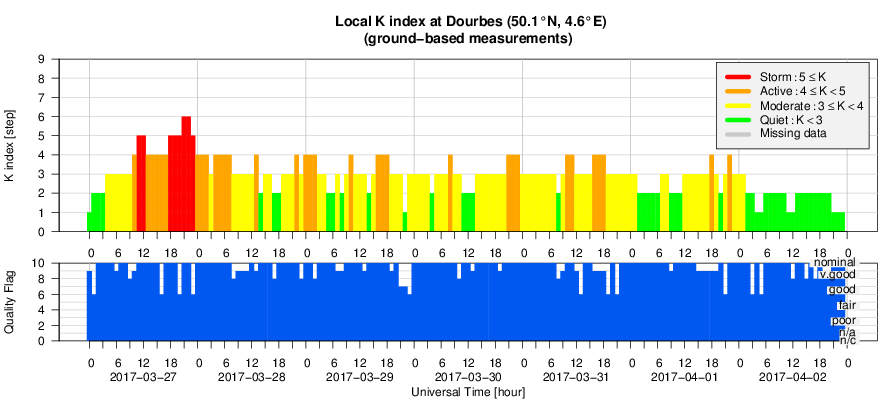- Table of Content
- 1.M-class flares...
- 2.PROBA2 Observa...
- 3.Review of sola...
- 4.Noticeable Sol...
- 5.The Internatio...
- 6.Geomagnetic Ob...
- 7.Review of iono...
- 8.Future Events
2. PROBA2 Observations (27 Mar 2017 - 2 Apr 2017)
3. Review of solar and geomagnetic activity
4. Noticeable Solar Events (27 Mar 2017 - 2 Apr 2017)
5. The International Sunspot Number
6. Geomagnetic Observations at Dourbes (27 Mar 2017 - 2 Apr 2017)
7. Review of ionospheric activity (27 Mar 2017 - 2 Apr 2017)
8. Future Events
M-class flares à volonté!
It's no April Fool's day joke: On 1 April, the Sun produced its first M-class flare since 29 November 2016. The source region was NOAA 2644, which had also broken the long solar flare silence the week before (see the news item at http://www.stce.be/news/383/welcome.html ). NOAA 2644 was actually a very quiet region, until early on 1 April when suddenly new magnetic flux emerged north of the main leading spot. Interacting with embedded opposite magnetic polarity spots, it didn't take long before the active region started to produce intense flares. A compilation of SDO movies (https://sdo.gsfc.nasa.gov/data/aiahmi/ ) created with JHelioviewer software (http://www.jhelioviewer.org/ ) can be found at http://stce.be/movies/NOAA2644.wmv

The first movie (screenshot above) compares white light imagery with magnetic development. One can easily see the emergence of the magnetic flux (negative (inward); blue) and subsequent development of the large and complex sunspots. In fact, around 31 March (beginning of the movie), the total area of the sunspots was similar to the total surface area of the Earth. However, just a few days later, it had tripled in size! The next clip shows the evolution on 1 and 2 April in white light (about 6000 degrees) and 3 passbands in extreme ultraviolet (EUV) at temperatures of resp. 80.000 degrees (AIA304; red), 700.000 degrees (AIA171; green) and several million degrees (AIA131; blue). There's an obvious increase in number and intensity of the flares as the sunspot group grows in size and magnetic complexity. The still image shows the M4.4 flare just after its peak x-ray flux on 1 April. It was the first of the series of 7 M-class flares produced by NOAA 2644.

The next two movie clips in the compilation show some of the strongest flares produced by NOAA 2644. The first movie compares white light and EUV (AIA131) imagery. It concerns the M5.7 flare on 2 April peaking at 20:33UT, preceded by a long duration M2 flare just 2 hours before. The latter shows a very nice cusp ("candle flame"), indicative of magnetic reconnection. The M5.7 event was a more violent eruption, taking place in the northerly portion of the region. The second movie also compares white light and EUV (AIA304) imagery. It concerns the M5.8 flare that peaked on 3 April at 14:29UT. The images show a massive ejection of plasma, with some of the material channeling back along the magnetic field lines to the solar surface afterwards.

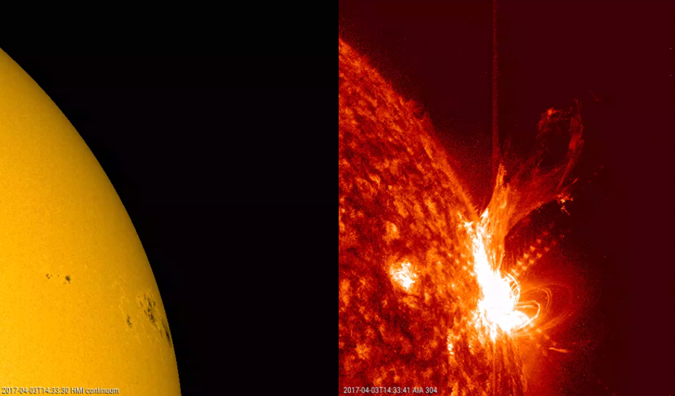
Radio telescopes in Humain were able to capture the radio burst associated with the latter flare (M5.8). The picture underneath is a radiospectrum that combines observations from ARCAS (45 – 275 MHz in this plot) and HSRS (275 – 1495 MHz), both radio receivers at the Humain Solar Radio Observatory. The frequency scale is plotted on a logarithmic scale (vertical axis) and decreasing upward. More info on these receivers in the STCE Newsitem at http://www.stce.be/news/369/welcome.html and real-time imagery at their website at http://www.sidc.be/humain/humain_spectra_realtime.php
A clear radio disturbance can be seen around the time of the x-ray flare (see annotated version at http://stce.be/movies/Picture5_ann.png ), at about 14:25UT. This is a type II burst, and indicative of a shock propagating through the corona, the Sun's outer atmosphere. The associated coronal mass ejection was not directed to Earth. It was the first Type II radio burst observed by ARCAS (Augmented Resolution Callisto Spectrometer) since it became operational late October 2016.
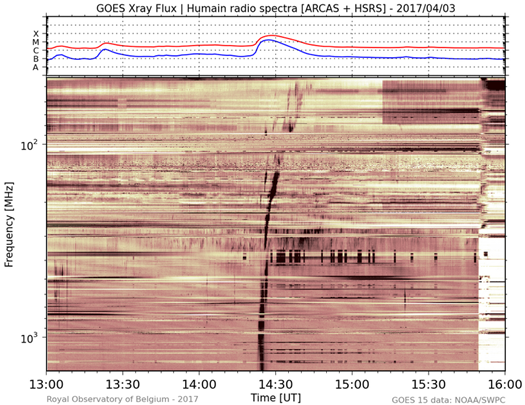
PROBA2 Observations (27 Mar 2017 - 2 Apr 2017)
Solar Activity
Solar flare activity fluctuated between very low and moderate during the week.
In order to view the activity of this week in more detail, we suggest to go to the following website from which all the daily (normal and difference) movies can be accessed: http://proba2.oma.be/ssa
This page also lists the recorded flaring events.
A weekly overview movie can be found here (SWAP week 366):
http://proba2.oma.be/swap/data/mpg/movies/weekly_movies/weekly_movie_2017_03_27.mp4
Details about some of this week's events, can be found further below.
If any of the linked movies are unavailable they can be found in the P2SC movie repository here:
http://proba2.oma.be/swap/data/mpg/movies/
Saturday Apr 01
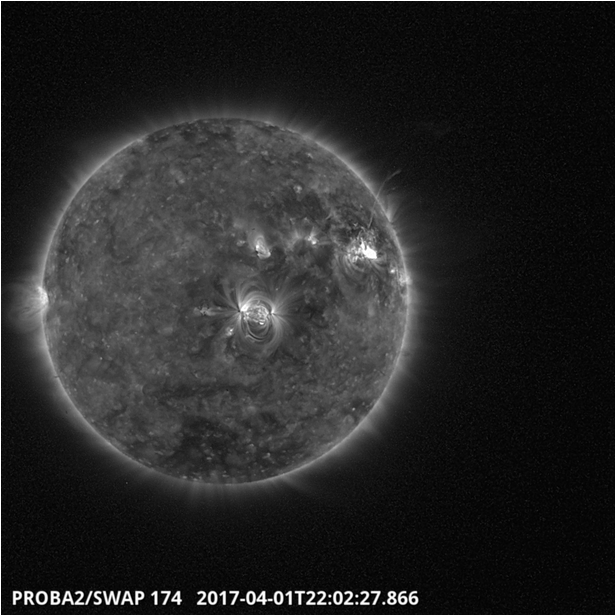
The first M class flare of the week (an M4.4) and a corresponding eruption was observed by SWAP near the west limb of the Sun on 2017-Apr-01, shown here at 22:02 UT, while SWAP was off-pointed to the solar west.
Find a movie of the event here (SWAP movie of off-pointed images):
http://proba2.oma.be/swap/data/mpg/movies/20170401_swap_movie_with_offpoint.mp4
Sunday Apr 02
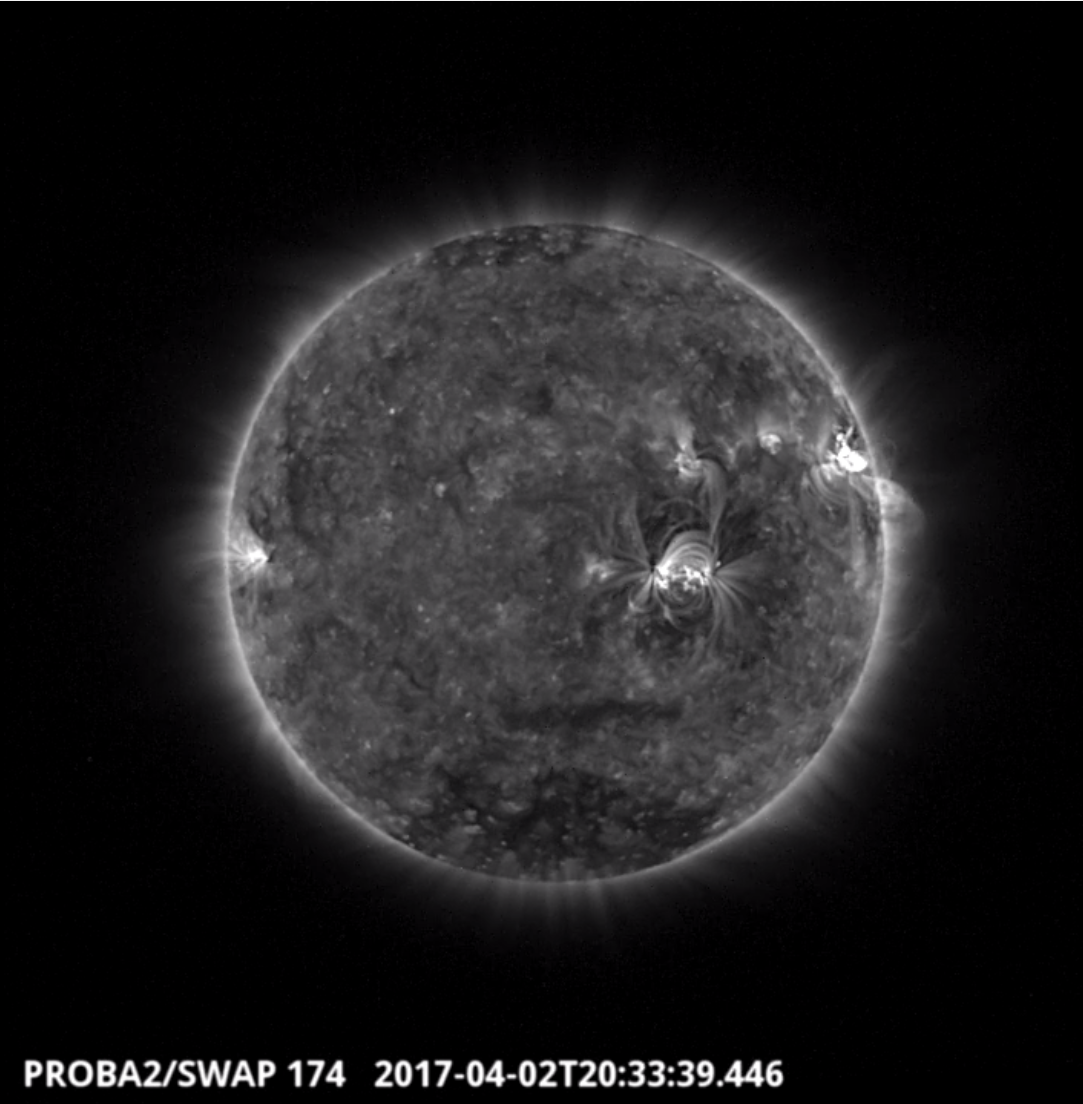
The largest flare (M5.7) of the week, also from AR 12644, was observed by SWAP near the west limb of the Sun on 2017-Apr-02 and shown here at 20:33 UT.
Find a movie of the event here (SWAP movie):
http://proba2.oma.be/swap/data/mpg/movies/20170402_swap_movie.mp4
Review of solar and geomagnetic activity
Solar Activity
Two important active regions were present during the period: NOAA AR 2644 in the Northern hemisphere and NOAA AR 2645 in the Southern hemisphere. NOAA AR 2644 developed a beta-gamma magnetic configuration, NOAA AR 2645 evolved to a beta-gamma-delta magnetic configuration by the end of the week. From April 27, both regions started flaring in the C-level, on April 1 and 2, they produced six M-class flares.
Geomagnetic Activity
The co-rotating interaction region between slow and high speed solar wind associated with a negative polarity coronal hole (CH) arrived at earth March 26 as seen in data from the DSCOVR spacecraft. The solar wind increased from on March 27 and was at an elevated level of about 600-700 km/s from March 28 till April 01.
The geomagnetic activity index Kp reached 6 on March 27 and 5 on March 30, March 31.
The space weather briefing presented on Monday April 3

Noticeable Solar Events (27 Mar 2017 - 2 Apr 2017)
| DAY | BEGIN | MAX | END | LOC | XRAY | OP | 10CM | TYPE | Cat | NOAA |
| 01 | 2135 | 2148 | 2205 | N16W53 | M4.4 | 1F | III/2V/3IV/3 | 8 | 2644 | |
| 02 | 0433 | 0802 | 0813 | M5.6 | ||||||
| 02 | 0750 | 0802 | 0813 | N12W59 | M5.3 | 2N | III/2IV/1II/1 | 8 | 2644 | |
| 02 | 1252 | 1300 | 1311 | M2.3 | 110 | 8 | 2644 | |||
| 02 | 1818 | 1838 | 1928 | N16W68 | M2.1 | SF | III/1CTM/1 | 8 | 2644 | |
| 02 | 2026 | 2033 | 2038 | M5.7 | 8 | 2644 |
| LOC: approximate heliographic location | TYPE: radio burst type |
| XRAY: X-ray flare class | Cat: Catania sunspot group number |
| OP: optical flare class | NOAA: NOAA active region number |
| 10CM: peak 10 cm radio flux |
The International Sunspot Number

The daily Estimated International Sunspot Number (EISN, red curve with shaded error) derived by a simplified method from real-time data from the worldwide SILSO network. It extends the official Sunspot Number from the full processing of the preceding month (green line). The plot shows the last 30 days (about one solar rotation). The horizontal blue line shows the current monthly average, while the green dots give the number of stations included in the calculation of the EISN for each day.
Review of ionospheric activity (27 Mar 2017 - 2 Apr 2017)
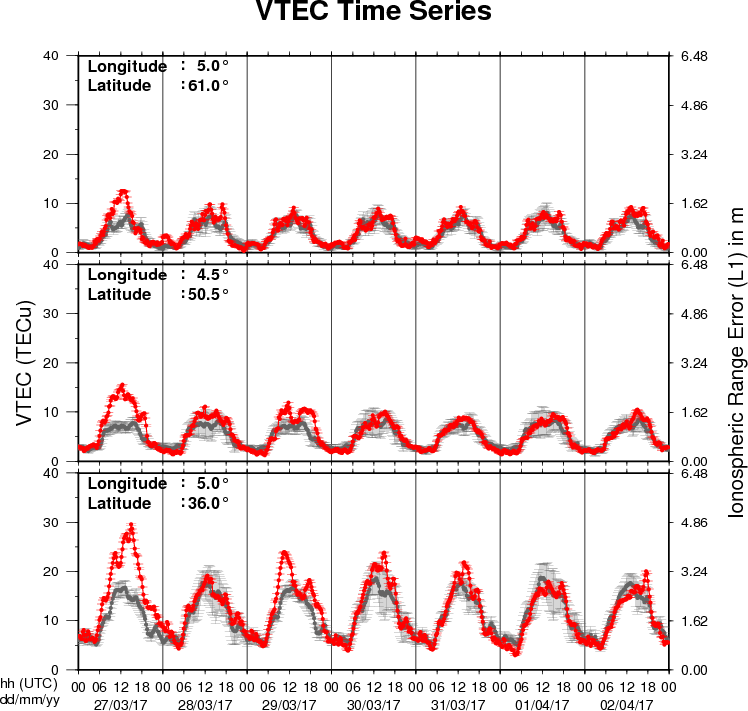
The figure shows the time evolution of the Vertical Total Electron Content (VTEC) (in red) during the last week at three locations:
a) in the northern part of Europe(N61°, 5°E)
b) above Brussels(N50.5°, 4.5°E)
c) in the southern part of Europe(N36°, 5°E)
This figure also shows (in grey) the normal ionospheric behaviour expected based on the median VTEC from the 15 previous days.
The VTEC is expressed in TECu (with TECu=10^16 electrons per square meter) and is directly related to the signal propagation delay due to the ionosphere (in figure: delay on GPS L1 frequency).
The Sun's radiation ionizes the Earth's upper atmosphere, the ionosphere, located from about 60km to 1000km above the Earth's surface.The ionization process in the ionosphere produces ions and free electrons. These electrons perturb the propagation of the GNSS (Global Navigation Satellite System) signals by inducing a so-called ionospheric delay.
See http://stce.be/newsletter/GNSS_final.pdf for some more explanations ; for detailed information, see http://gnss.be/ionosphere_tutorial.php
Future Events
For more details, see http://www.spaceweather.eu/en/event/future
URSI General Assembly in Montreal, Canada
Start : 2017-08-19 - End : 2017-08-26
For the thirty-second time since the inception of URSI, Radio
Scientists from across the world will get together for the URSI
General Assembly and Scientific Symposium. This triennial gathering
will take place from 19th to 26th of August 2017, in Montreal,
Canada. This conference is a unique opportunity to learn about
recent advances in all fields of Radio Science, as covered by all
ten URSI Commissions.
Among the different sessions, please note:
* 'Radio Science for Space Weather'
Conveners: M. Messerotti, V. Pierrard
* 'Remote Sensing and Modeling of the Earth's Plasmasphere
and Plasmapause'
Conveners: A. M. Jorgensen, V. Pierrard, B. Heilig
The abstract deadline is 30 January 2017
Website: http://www.ursi2017.org
2017 Joint IAPSO-IAMAS-IAGA Assembly in Cape Town, South Africa
Start : 2017-08-27 - End : 2017-09-01
The Joint IAPSO-IAMAS-IAGA Assembly, endorsed by the University
of Cape Town and the South African Department of Science and
Technology, will take place from 27 August to 1 September 2017 at
the Cape Town International Convention Centre (CTICC). Several IAGA
and IAMAS sessions are of Space Weather interests as well as the
joint session 'Space Weather throughout the Solar System: Bringing
Data and Models together'.
Website:
http://iapso-iamas-iaga2017.com/index.php
Workshops on Radiation Monitoring for the International Space Station in Torino, Italy
Start : 2017-09-05 - End : 2017-09-07
The Workshop on Radiation Monitoring for the International Space
Station is an annual meeting to discuss the scientific definition
of an adequate radiation monitoring package and its use by the
scientific community on the ISS. Types of instruments and research
topics need to be defined in order to optimise the radiation safety
of the ISS crew.
Website: http://wrmiss.org/
International Workshop on Solar, Heliospheric & Magnetospheric Radioastronomy in Meudon, France
Start : 2017-11-06 - End : 2017-11-10
Jean-Louis Steinbeg has been one of the major pioneers in
radioastronomy. Co-founder of the Nançay Observatory, he
has actively participated to, an inspired a large number of radio
instruments on many international space missions. Jean-Louis
Steinberg is the founder of the Space Radioastronomy laboratory of
the Paris Observatory in 1963. Later on, this laboratory widened
its science interests and became the DESPA (1971) and then the
current LESIA (2002) which is one of the major space sciences
laboratories in France. The aim of this workshop is to cover the
science topics which Jean-Louis Steinberg has promoted during his
career, focusing on Solar, Heliospheric & Magnetospheric
radioastronomy & physics. This will be done by covering both
observations from either ground facilities (NDA, RH, LOFAR, Artemis
etc ...) or space missions (ISSEE, Ulysses, WIND, CLUSTER, STEREO,
CASSINI, JUNO etc ...) and models/theories. A series of invited
talks is also foreseen to cover the new developments in the
discipline which may come with the future facilities such as Solar
Orbiter, Solar Probe Plus, JUICE, JUNO, LOFAR+, SKA etc ....
This workshop will also be the opportunity to remember both the
extraordinary personal & professional lifes of Jean-Louis
Steinberg especially for new generation of scientists. At the
occasion of this workshop it is also expected that the Building 16
(historical Space Sciences building) on the Meudon campus will be
renamed "Building Jean-Louis Steinberg".
Website:
https://jlsworkshop.sciencesconf.org/
European Space Weather Week 14
Start : 2017-11-27 - End : 2017-12-01
The ESWW is the main annual event in the European Space Weather
calendar. It is the European forum for Space Weather as proven by
the high attendance to the past editions. The agenda will be
composed of plenary/parallel sessions, working meetings and
dedicated events for service end-users. The ESWW will again adopt
the central aim of bringing together the diverse groups in Europe
working on different aspects of Space Weather.
Website:
http://www.stce.be/esww14/
